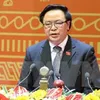Opportunities for M&As in Vietnam's real estate market
Earlier this year Vietnam’s real estate market saw a huge acquisition made when AON Holdings, a mid-sized financial group from the Republic of Korea (RoK), officially took over Vietnam’s tallest building, Keangnam Hanoi Landmark 72 in Hanoi, after a series of scandals in the RoK hit the parent company.
It was a good beginning for merger and acquisition (M&A) activities in the new year and there are expected to be many more investors pouring capital into the real estate market via M&A over the course of 2016.
Year of M&A
Several years ago, when Vietnam’s real estate market was in the doldrums, investment by domestic and foreign investors alike was extremely muted.
Since mid-2014 and especially since the beginning of 2015 the real estate market has welcomed more foreign capital inflows, especially from Asian countries.
Vietnam is becoming a comparatively more attractive destination for foreign capital in the medium term compared to many other Southeast Asian countries.
Several private equity funds have allocated capital to the country in a bid to increase their presence.
For instance, in the second quarter of 2015 a consortium led by Warburg Pincus, the US private equity firm, injected an additional US$100 million into Vincom Retail, the country’s largest shopping mall owner and operator.
In the same quarter Gaw Capital Partners acquired four assets across multiple asset classes from Indochina Land, with a price tag of US$106 million, together with their local joint venture partner, NP Capital. Gamuda Land also acquired a 40% stake, equal to US$64.1 million, in Celadon City, a modern township project initiated by Sacomreal, Thanh Thanh Cong (TTC), and An Phu Gia.
According to the Ministry of Planning and Investment, foreign direct investment (FDI) into Vietnam’s industrial park (IP) segment accounted for 67% of the US$11 billion in total capital and 59% of the 1,400 projects in the nine-month period from January to September 2015.
One noteworthy transaction was Amata Corporation’s purchase of a development site for US$279 million in Dong Nai province’s Long Thanh district, for a US$500 million IP and township development.
Foreign investors present in Vietnam for many years have also found funding to expand their operations. Singapore’s Keppel Land decided to expand its project portfolio by spending approximately US$26.7 million on acquiring housing developments of the Tien Phuoc Company.
It also cooperated with the Hanoi Westgate Joint Venture Company to invest US$140 million in the Hanoi Westgate project.
Many other M&A activities have also taken place, such as Sunwah Group investing US$200 million in projects to build apartment blocks in Ho Chi Minh City’s Binh Thanh district, and Global Emerging Market (GEM) investing US$20 million in the Hoang Quan Real Estate Company (HQC).

Mr. Stephen Wyatt, Country Head of Jones Lang LaSalle (JLL), agrees that Vietnam has witnessed a significant increase in M&A activities over the last 12 months and believes this is set to continue.
There is a considerable amount of investor interest within Southeast Asia and Vietnam is gaining much of that attention and is very much back “on the radar” for both domestic and foreign investors.
“This can be attributed to a growing economy and a property market that has reached the bottom of the cycle,” he said.
“Foreign investors are prepared to look at a number of ways to invest in Vietnam. Their main criteria for looking at opportunities will depend on location, deal size, ownership structure, remaining term of lease, the quality and track record of the joint venture partner, and any outstanding legal issues, and above all the acquisition will have to be viable, as it is unlikely any foreign investor will pay above market value for an asset, unless it is a ‘trophy asset’ or has the potential to add significant value by proactive asset management or has a potential upside from improvements in infrastructure.”
Mr. Nguyen Hong Son, Head of Research and Consultancy at Savills, meanwhile, said that after a period of market decline and a refinement between investors and projects, investors now operate more professionally and are stronger.
“They therefore have the ability to acquire other projects to develop land and products,” he said. “M&A will be active in the years to come as a result.”
Domestic investors emerge
As the market recovers many domestic enterprises are also experiencing strong growth. Domestic enterprises have also had a dominant position in M&As in real estate, leading the market and cooperating with foreign investors.
While foreign capital flows have only just started to return to Vietnam, many large real estate businesses in the country, such as Vingroup, Novaland, and FLC Group, implemented strategies to “hunt” projects back when the market was still frozen.
In late 2015 the Khang Dien House Trading and Investment Joint Stock Company (KDH) officially acquired Binh Chanh Construction Investment (BCI), with KDH picking up BCI’s land sources of 667 ha in the west of Ho Chi Minh City.
Though preferring not to provide details of its M&A activities in 2015, a representative from KDH told VET that conducting M&A transactions is a regular activity of the company in building and developing projects.
In 2013 and 2014, when the real estate market faced difficulties, many companies were unable to continue projects for financial reasons.
Novaland quietly acquired many prime project locations and is now conducting a host of projects in many districts of Ho Chi Minh City.
Another real estate giant, the Hung Thinh Corporation, has been successful in a series of M&A endeavors.
In the last two years it has acquired or invested in dozens of real estate projects, Chairman Nguyen Dinh Trung was quoted as saying.
Most recently the corporation acquired two projects in Ho Chi Minh City’s District 7 of the Duc Khai Company and another project in the southern coastal city of Vung Tau, which are now under construction.
In the north of the country, FLC Group is among the notable names to acquire projects with prime locations, such as the Alaska Dai Mo project of the Alaska Land Joint Stock Company, the 36 Pham project of the Hai Phat Joint Stock Company, and, most recently, a project at 265 Cau Giay Street in Hanoi’s Cau Giay district from the Chemicals and Scientific Technological Materials Joint Stock Company.
Local businesses possess many advantages in M&A transactions, Mr. Wyatt told VET.
“There has been considerable press coverage on foreign investment in Vietnam, but the majority of transactions within the real estate market are carried out by local investors, especially real estate developers such as Novaland Group, An Gia Investment, and Vingroup,” he said.
“While foreign investors tend to be a little bit more conservative and take a lot of time to review the market, domestic investors understand legislation very well so we generally see them move much quicker than foreign companies.”
“As transactions take place in the market we have found that local businesses are at an advantage in project development,” Mr. Son said.
“When they acquire a project, if it is not appropriate they can adjust it much faster and more easily than foreign investors.”
Unprecedented excitement
In this year and for years to come, M&A activities in real estate will benefit from market reforms. Many important laws have been passed and come into effect, such as the amended Law on Investment, the amended Law on Enterprises, the Law on the Management and Use of State Capital Investments in Production - Business, the amended Law on Housing, the amended Law on Real Estate Business, and Decree No. 60/2015/ND-CP, which eases restrictions on foreign investors.
All assist the regulatory environment for business activities in general and M&A activities in particular.
Along with improvements in economic institutions, Vietnam’s continued integration process is also opening up new opportunities for M&A activities in real estate.
The buying of stalled real estate projects is also expected to be vibrant this year. Shifting projects from struggling investors to stronger businesses is the best way to resolve high inventories and bad debts in the real estate market, according to Mr. Le Hoang Chau, Chairman of the Vietnam National Real Estate Association.
Of the 1,409 projects now under construction in Ho Chi Minh City, 190 projects have had their license revoked or canceled and 502 have temporarily ceased construction after getting underway. These are potential sources of M&A transactions in the future.
With favorable signs in the market, a number of new investors from the US, Europe, the Middle East, and India are looking to join some of the more established investor groups from Japan, the RoK, Hong Kong, the Philippines and Indonesia, who are all actively looking to get a piece of the real estate market in Vietnam, Mr. Wyatt predicted.
“Singaporean developers have always regarded Vietnam as the ‘apple of their eye’ and despite a slowdown over recent years Vietnam continues to be an attractive destination for investment, including for well-known groups around the world,” he said.
“With a significant amount of interest from both foreign and domestic investors, we expect 2016-2018 to be bumper years for M&A activities,” he added.
Tags:





